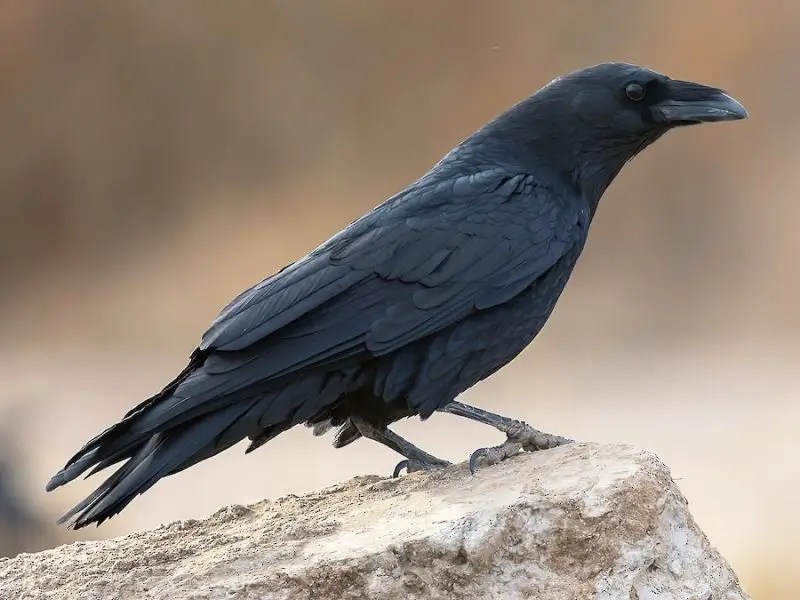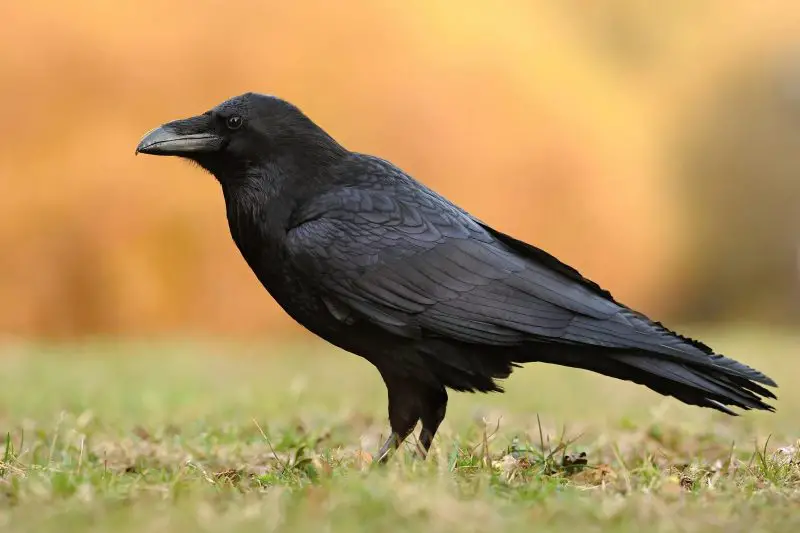Arizona’s deserts, canyons, and grasslands provide a rich habitat for some of the most striking members of the crow and raven family. Although true crows are less common here than in other regions of the United States, the state offers excellent opportunities to observe both crows and ravens in the wild.
The American Crow, Chihuahuan Raven, and Common Raven are the three primary species found across Arizona. Each has its own preferred environment, ranging from city edges and farmland to remote deserts and high mountain cliffs. Their intelligence, adaptability, and complex social lives make them fascinating to study and watch.
Travelers and bird enthusiasts exploring Arizona’s varied landscapes will encounter these remarkable black birds in different settings. Learning how to distinguish them enhances the experience and deepens appreciation for their ecological importance.
Table of Contents
Different Types of Crows Found in Arizona
American Crow (Corvus brachyrhynchos)

The American Crow is one of the few true crows found in Arizona, though its range within the state is limited compared to other regions of North America. It is most often seen in northern and central Arizona, particularly in areas with woodlands, agricultural fields, and towns. This species is medium-sized, measuring about 16–21 inches in length with a wingspan close to three feet. Its all-black plumage, sturdy bill, and rounded tail are distinctive traits, though they can make it difficult to distinguish from other black corvids at a distance.
These crows are incredibly intelligent and social, often forming small family groups or larger flocks outside the breeding season. They communicate with a wide range of calls, but their harsh, repetitive “caw” is the most recognizable. American Crows are known to recognize human faces, cache food for later, and even use simple tools, showing their adaptability to both natural and human-dominated environments.
Their diet is highly varied, consisting of insects, seeds, fruits, small mammals, reptiles, carrion, and human food scraps. In Arizona, they are often seen feeding in open fields or scavenging along roadsides. During autumn and winter, they may gather in communal roosts, sometimes with hundreds of individuals grouped together for safety and warmth.
Although they are not as abundant in Arizona as in the Midwest or East Coast, American Crows are expanding their presence in urban and agricultural landscapes of the state. Their adaptability, intelligence, and opportunistic feeding habits allow them to survive in the diverse habitats Arizona offers, from rural farmland to bustling city environments.
Chihuahuan Raven (Corvus cryptoleucus)

The Chihuahuan Raven is one of the most common corvids in Arizona, particularly in the southern and central parts of the state. Slightly larger than the American Crow but smaller than the Common Raven, it measures about 18–20 inches in length. At first glance, it looks very similar to a crow, but it can be identified by its wedge-shaped tail and the white base of its neck feathers, which can be seen when the wind parts its glossy black plumage.
This raven thrives in open landscapes, favoring deserts, grasslands, scrublands, and agricultural fields. Unlike American Crows, which often live in towns and cities, Chihuahuan Ravens prefer wide, open spaces where they can perch on utility poles, fence lines, or isolated trees. They are especially numerous in southeastern Arizona, near the desert grasslands that border Mexico.
Chihuahuan Ravens have a highly adaptable diet. They feed on insects, small rodents, reptiles, grains, fruits, and carrion. In farming regions, they can often be seen foraging in freshly plowed fields, picking insects and seeds from the soil. They are also opportunistic scavengers, frequently feeding on roadkill or livestock carrion, which makes them a familiar sight in rural ranching areas of Arizona.
In Arizona, these ravens often form large flocks outside the breeding season. These gatherings can number in the hundreds and are sometimes observed performing aerial acrobatics, filling the skies with their raspy calls. Their abundance and social behavior make them one of the most noticeable and ecologically important corvids in the state.
Common Raven (Corvus corax)

The Common Raven is the largest and most widespread corvid in Arizona, easily distinguished by its massive size, heavy bill, and wedge-shaped tail. Measuring 22–27 inches long with a wingspan that can exceed four feet, it dwarfs both the American Crow and the Chihuahuan Raven. Its plumage is entirely black but shimmers with purples and blues in bright sunlight. Its deep, resonant “kraaa” call contrasts sharply with the higher-pitched caws of crows.
This raven is especially associated with Arizona’s rugged landscapes, thriving in deserts, mountains, canyons, and remote wilderness areas. It is commonly seen in iconic places such as the Grand Canyon, Monument Valley, and other rocky regions of northern and western Arizona. Unlike crows, which are more urban-adapted, Common Ravens prefer wild and open terrain, though they will occasionally approach human settlements in search of food.
Ravens are famous for their intelligence, ranking among the smartest birds in the world. They have been observed solving complex problems, mimicking sounds, playing games, and even working cooperatively to obtain food. Their diet is omnivorous and opportunistic, including small mammals, reptiles, insects, bird eggs, carrion, seeds, berries, and human food waste. This adaptability ensures their survival across Arizona’s diverse ecosystems.
In Arizona, Common Ravens are not only abundant but also play an important cultural role. They are revered in Native American traditions as symbols of wisdom, transformation, and survival. Their presence in the state’s deserts and mountains adds to the mystique of Arizona’s landscapes, making them a defining feature of the region’s natural heritage.
Comparison of Crows and Ravens in Arizona
|
Feature
|
American Crow (Corvus brachyrhynchos)
|
Chihuahuan Raven (Corvus cryptoleucus)
|
Common Raven (Corvus corax)
|
|---|---|---|---|
|
Size
|
Medium, 16–21 in long, ~3 ft wingspan
|
Medium-large, 18–20 in long
|
Largest, 22–27 in long, 4+ ft wingspan
|
|
Tail Shape
|
Rounded tail
|
Slightly wedge-shaped tail
|
Strongly wedge-shaped tail
|
|
Plumage
|
Glossy black, subtle iridescence
|
Glossy black, white feather bases at neck
|
Glossy black, iridescent purple/blue sheen
|
|
Call
|
Harsh “caw-caw”
|
Raspy, croaking calls
|
Deep, resonant “kraaa”
|
|
Habitat in Arizona
|
Northern & central towns, fields, woodlands
|
Southern & central deserts, grasslands, farmlands
|
Mountains, canyons, deserts, remote wilderness
|
|
Diet
|
Insects, grains, carrion, small animals, human scraps
|
Insects, rodents, reptiles, grains, carrion
|
Small mammals, reptiles, insects, carrion, fruits, human food
|
|
Social Behavior
|
Family groups, large winter roosts
|
Large flocks outside breeding season
|
Usually pairs or small groups, highly territorial
|
|
Abundance in AZ
|
Less common, localized in certain regions
|
Very common in open landscapes
|
Widespread, especially in northern & western Arizona
|
Best Time and Places to See Crows and Ravens in Arizona
The best time to observe crows and ravens in Arizona depends on the species and the landscapes they prefer. American Crows are most active in the cooler months, especially fall and winter, when they form large communal roosts in agricultural fields and wooded areas. Early mornings and late afternoons are the best times to spot them feeding in open fields or perched on urban trees in northern and central Arizona towns.
For Chihuahuan Ravens, the best time is during spring and summer in open desert grasslands and farmlands across southern and central Arizona. They are highly visible during the day, often perched on utility poles, fence posts, or foraging in freshly plowed fields. Large flocks can be seen in rural areas, especially near ranchlands.
Common Ravens are best observed year-round in Arizona’s rugged landscapes, including the Grand Canyon, Monument Valley, and the desert mountains of northern and western Arizona. They soar effortlessly on thermals during the late morning and early afternoon, making them easy to spot against the desert sky. Their presence in remote wilderness areas makes them a highlight for birdwatchers exploring Arizona’s national parks and desert regions.
FAQs about Crows and Ravens in Arizona
What is the most common crow-like bird in Arizona?
The Chihuahuan Raven is the most common crow-like species in Arizona, especially in open grasslands and deserts. It is often mistaken for a crow because of its size and appearance.
How can you tell the difference between a crow and a raven in Arizona?
Ravens are larger, with wedge-shaped tails and deeper, croaking calls. Crows are smaller with rounded tails and sharp “caw” calls. Chihuahuan Ravens can be distinguished from American Crows by the white bases of their neck feathers.
Do crows and ravens live in cities in Arizona?
Yes, but mainly American Crows adapt well to cities and suburban areas. Ravens, particularly the Common Raven, prefer more remote and wild landscapes, while Chihuahuan Ravens are most common in rural and agricultural zones.
Are crows and ravens migratory in Arizona?
Most crows and ravens in Arizona are year-round residents. However, American Crows may form seasonal flocks that shift locations depending on food availability.
Where is the best place in Arizona to see ravens?
The Grand Canyon National Park, Monument Valley, and the Trans-Pecos desert regions are excellent places to see Common Ravens. Chihuahuan Ravens are best seen in southern Arizona’s open rangelands and desert grasslands.

